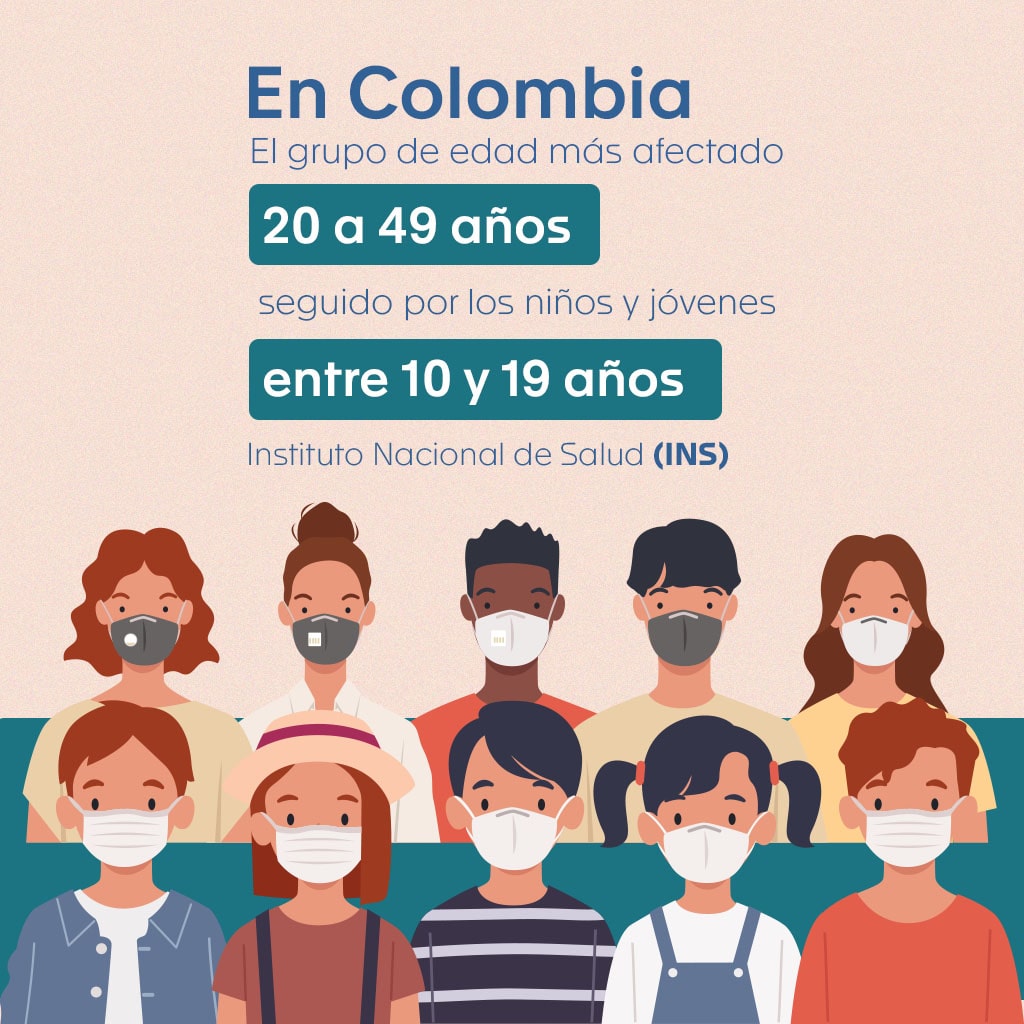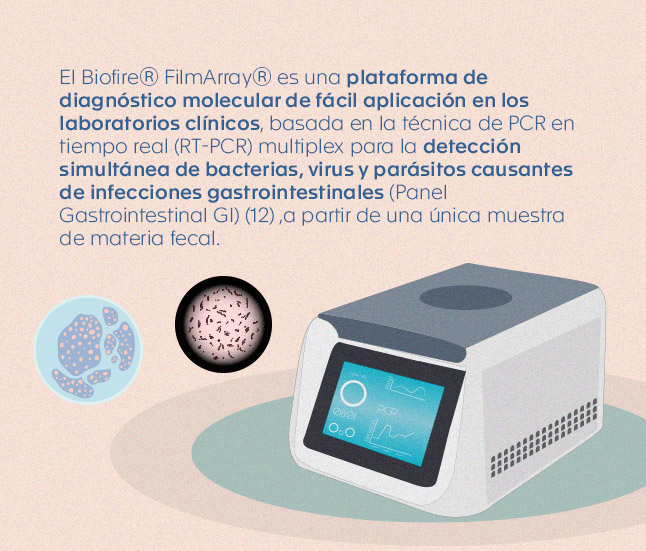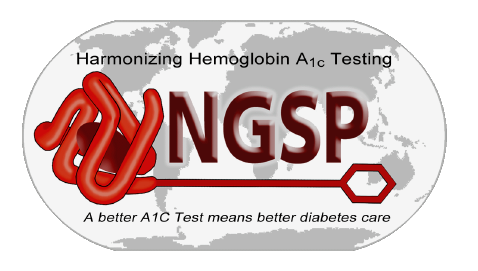Prueba
Paneles de BiofireⓇ FilmArrayⓇ
BiofireⓇ FilmArrayⓇ panels for molecular diagnosis of acute gastrointestinal infections
By: Jairo A. Mesa Arango*, Natalia Loaiza Díaz**.
* Molecular Laboratory Scientist, PhDc in Biology, Laboratorio Clínico Hematológico S.A. Medellín, Colombia.
** Head of Clinical Pathology, Medical Specialist in Microbiology, Laboratorio Clínico Hematológico S.A. Medellín, Colombia.
Published on 01-06-2021
Acute gastroenteritis and foodborne illness are a frequent cause of illness and death worldwide, and the leading cause of diarrheal disease in children under 5 years of age. Gastrointestinal (GI) conditions of infectious origin occur as a consequence of consuming water and food contaminated with viruses, bacteria and parasites. These infections, usually accidental, occur worldwide; however, they occur more frequently in regions of developing countries where hygienic-sanitary measures are insufficient or where access to sanitation and drinking water is limited.
According to data published by the World Health Organization (WHO) in 2015, each year there are about 600 million cases and 420,000 deaths derived from GI conditions, of which 30% affect children under 5 years of age. In Colombia, according to data reported by the National Institute of Health (INS), in 2019, 997 foodborne illness outbreaks were reported, with a total of 11,222 people affected. Among these, the most affected age group was 20 to 49 years old, followed by children and young people between 10 and 19 years old. In addition, about half of these situations occurred at home and the rest in restaurants, schools and places that favor close contact between people. It is important to highlight that only in the department of Antioquia 21.4% (2,401) of these cases occurred.
Gastroenteritis of infectious origin are caused by a great variety of bacteria, viruses and parasites (e.g. Norovirus sp., Campylobacter spp., Salmonella enterica non-typhi, enteropathogenic Escherichia coli, Taenia Solium, Giardia sp, among others) and can manifest themselves in different ways, causing from mild diarrhea that does not require treatment to situations of difficult management that can put the patient’s life at risk, such as hemolytic uremic syndrome and pseudomembranous colitis. In these cases, specific and rapid identification of the pathogen causing the clinical picture is essential to define or adjust pharmacological and non-pharmacological therapy and contain possible outbreaks of infection.

Diagnosis of gastrointestinal infections in clinical laboratories
Traditional diagnosis:
Microbiological diagnosis of gastrointestinal infections caused by bacteria, fungi, viruses and parasites has traditionally focused on direct microscopic visualization and culture of the microorganisms present in fecal material. In this way, their isolation and identification is achieved through the study of phenotypic and biochemical characteristics, and the range of susceptibility to antimicrobials, which allow the diagnosis to be established and timely clinical and pharmacological management to be carried out.
Traditional methodologies can be complemented with serological tests that directly or indirectly detect antigens of the microorganism under study, or antibodies against it, present in blood, serum or body fluid samples. This type of test is especially relevant in cases of infections caused by viruses, which are difficult to detect due to their small size (which makes microscopic visualization difficult) and their complexity for handling by culture techniques.
Traditional microbiological procedures continue to be the methods of choice for routine laboratory diagnosis, as they are cost-effective and cover the diagnosis of a significant number of infections caused by pathogenic agents or microorganisms. However, they present multiple limitations such as the execution of laborious protocols and extensive workflows (24-48 hours on average, and even days), limited performance (sensitivity/specificity), limited application in the study of microorganisms that cannot be cultured by conventional methods, and the difficulty of achieving a definitive diagnosis. The above, added to the variations that can be induced due to the technique used, the type of sample, the pathogen sought and its concentration in the sample. In addition, their detection capacity is limited to one or at most two types of pathogens simultaneously.

Molecular diagnosis:
Molecular techniques have revolutionized the way infections are diagnosed, since they allow the simultaneous detection of different species of microorganisms in the same assay (single or polymicrobial infections) and the massive study of samples. Molecular tests can be applied directly to clinical samples from patients for the detection of the nucleic acids (DNA/RNA) present, from which taxonomic identification (genus, species and subspecies or variants of the microorganism) and molecular characterization of the agent(s) involved for diagnostic purposes are possible.
Currently, techniques based on molecular biology allow cost-effective diagnosis, with greater sensitivity and specificity, and less expensive than traditional microbiological tests. Molecular diagnostic tests, in addition to favoring rapid typing of non-culturable pathogenic microorganisms, make it possible to quantify the microorganisms identified and detect genes associated with antimicrobial resistance in a matter of hours, which significantly reduces the time it takes to obtain results (8-12 hours on average) and facilitates the management and timely treatment of infections by medical personnel.
The BiofireⓇ FilmArrayⓇ is a molecular diagnostic platform for easy application in clinical laboratories, based on multiplex real-time PCR (RT-PCR) for the simultaneous detection of bacteria, viruses and parasites causing gastrointestinal infections (Gastrointestinal GI Panel), from a single stool sample. The workflow includes short periods of handling and preparation of the samples (2-5 minutes) and its automated run consumes between 45 and 90 minutes from assembly to analysis and reporting, which guarantees fast and reliable results with diagnostic utility for these infections.


**In the Laboratorio Clínico Hematológico we have available the GI BiofireⓇ FilmArrayⓇ panel:
- Verified according to the requirements of national and international regulatory bodies.
- It uses the multiplex RT-PCR technique for the detection of gastrointestinal pathogens.
- It allows obtaining results in less than two (2) hours.
- It is performed from a fecal sample that can be delivered to any of our offices in less than 2 hours after its collection, if it is not preserved in the Cary Blair transport medium, or during the course of the day if it is preserved in the transport medium.
**In conclusion, the use of multiplex panel-type diagnostic tests such as the BiofireⓇ FilmArrayⓇ allows the timely and accurate establishment of the pathogens most commonly implicated in gastrointestinal infections, supports medical personnel in the timely definition of pharmacological treatments and clinical-epidemiological behaviors necessary for the rapid rehabilitation of patients, while preventing the spread of infections to others and controlling ongoing outbreaks. This translates into a reduction of health care costs due to unnecessary admissions and treatments (e.g. reduction of hospital stay), reduction of antibiotic resistance due to unnecessary prescription and use (e.g. use of drugs with no clinical utility in viral infections), and rational and efficient use of health care resources.
Bibliography
- Caldas Arias L. Enfermedad diarreica aguda. Rev Salud. 2020;03:7.
- Troeger C, Blacker BF, Khalil IA, Rao PC, Cao S, Zimsen SR, et al. Estimates of the global, regional, and national morbidity, mortality, and aetiologies of diarrhoea in 195 countries: a systematic analysis for the Global Burden of Disease Study 2016. Lancet Infect Dis. 2018;18(11):1211-28.
- World Health Organization. WHO estimates of the global burden of foodborne diseases: foodborne disease burden epidemiology reference group 2007-2015. Ginebra, Suiza: WHO Press; 2015. 255 p.
- Zarate AC. Investigación de brote enfermedades transmitidas por alimentos. 2020;03.
- Sotelo-Coronado JI, Flores-Aréchiga A, Llaca-Díaz J, Pérez-Chávez F, Lozano-Quintanilla S, Casillas-Vega N. Review: Associated microorganisms to gastrointestinal infections. Rev Latinoam Patol Clin Med Lab. 2016;63(4):206-10.
- Bou G, Fernández-Olmos A, García C, Sáez-Nieto JA, Valdezate S. Métodos de identificación bacteriana en el laboratorio de microbiología. Enfermedades Infecc Microbiol Clínica. 2011;29(8):601-8.
- Vila J, Álvarez-Martínez MJ, Buesa J, Castillo J. Diagnóstico microbiológico de las infecciones gastrointestinales. Enfermedades Infecc Microbiol Clínica. 2009;27(7):406-11.
- Khardori N. Future of diagnostic microbiology. Indian J Med Microbiol. 2014;32(4):371-7.
- Vira H, Bhat V, Chavan P. Diagnostic Molecular Microbiology and its applications: Current and Future Perspectives. Clin Microbiol Infect Dis. 2016;1(1):20-31.
- Buchan BW, Ledeboer NA. Emerging technologies for the clinical microbiology laboratory. Clin Microbiol Rev. 2014;27(4):783-822.
- Amjad M. An Overview of the Molecular Methods in the Diagnosis of Gastrointestinal Infectious Diseases. Int J Microbiol. 2020;2020.
- Piralla A, Lunghi G, Ardissino G, Girello A, Premoli M, Bava E, et al. FilmArrayTM GI panel performance for the diagnosis of acute gastroenteritis or hemorragic diarrhea. BMC Microbiol. 2017;17(1):1-10.
- BioFire Diagnostics. Guía rápida del FilmArray TM Gastrointestinal Panel.
- Balsalobre-Arenas L, Alarcón-Cavero T. Diagnóstico rápido de las infecciones del tracto gastrointestinal por parásitos, virus y bacterias. Enfermedades Infecc Microbiol Clínica. 2017;35(6):367-76.
- Lozano C, Torres C. Actualización en la resistencia antibiótica en Gram positivos. Enfermedades Infecc Microbiol Clínica. 2017;35:2-8.
- Vila J, Gómez MD, Salavert M, Bosch J. Métodos de diagnóstico rápido en microbiología clínica: necesidades clínicas. Enfermedades Infecc Microbiol Clínica. 2017;35(1):41-6.



